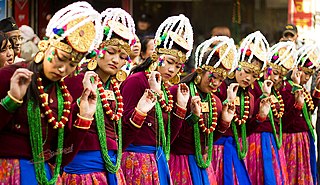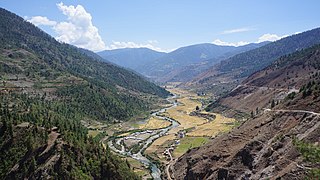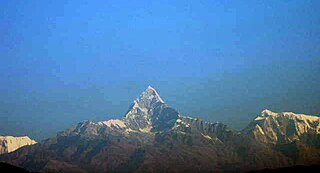Music of Nepal refers to the various musical genres played and listened to in Nepal. With more than fifty ethnic groups in Nepal, the country's music is highly diverse. Genres like Tamang Selo, Chyabrung, Dohori, Adhunik Geet, Bhajan, Filmi music, Ghazal, Classical music, songs and Ratna music are widely played and popular, but many other less common genres are yet to be cataloged. Western musical genres like Rock, Metal, Hip-Hop, Rap, R&B also regularly feature on the Nepalese music charts. Most of the country's musical bands are based in the Kathmandu valley. Musical genres from Tibet and India have greatly influenced Nepalese music.

Gurung or Tamu are an ethnic group indigenous to the hills and mountains of Gandaki Province of Nepal. Gurung people predominantly live around the Annapurna region in Manang, Mustang, Dolpo, Kaski, Lamjung, Gorkha, Parbat,Tanahun and Syangja districts of Nepal. They are one of the main Gurkha tribes.

The Tamang, are a Tibeto-Burman ethnic group of Nepal, Southern Bhutan and North India. In Nepal, Tamang/Moormi people constituted 5.6% of the Nepalese population at over 1.3 million in 2001, increasing to 1,539,830 as of the 2011 census. The Tamang people are concentrated in the central hilly region of Nepal. Indian Tamangs are found in significant numbers in the state of Sikkim and the districts of Darjeeling and Kalimpong in West Bengal state. Bhutanese Tamangs are native to various districts in the southern foothills of the Kingdom of Bhutan. Such districts include the Tsirang District, the Dagana District, the Samtse District, the Chukha District, the Sarpang District and the Samdrup Jongkhar District. Tamang language is the fifth most-spoken language in Nepal.
Buddhism in Nepal started spreading since the reign of Ashoka through Indian and Tibetan missionaries. The Kiratas were the first people in Nepal who embraced Gautama Buddha’s teachings, followed by the Licchavis and Newar people. Buddha was born in Lumbini in the Shakya Kingdom. Lumbini lies in present-day Rupandehi District, Lumbini zone of Nepal. Buddhism is the second-largest religion in Nepal. According to 2001 census, 10.74% of Nepal's population practiced Buddhism, consisting mainly of Tibeto-Burman-speaking ethnicities and the Newar. However, in the 2011 census, Buddhists made up just 9% of the country's population.

Jumla District, is one of the ten districts of the Karnali province of Nepal. This district has Jumla as its headquarters, an area of 2,531 square kilometres (977 sq mi); it had populations of 89,427 and 108,921, respectively, in the national censuses of 2001 and 2011. Its territory lies between longitudes 81⁰ 28' and 82⁰ 18' East, and between latitudes 28⁰ 58' and 29⁰ 30' North.

Lamjung District, a part of Gandaki Province, is one of the 77 districts of Nepal. The district, with Besisahar as its district headquarters, covers an area of 1,692 square kilometres (653 sq mi) and as of 2011 had a population of 167,724. Lamjung lies in the mid-hills of Nepal spanning tropical to trans-Himalayan geo-ecological belts, including the geographical midpoint of the country. It has mixed habitation of casts and ethnicities. It is host to probably the highest density of the Gurung ethnic population in the country.

Manang District (Nepali: मनाङ जिल्ला, a part of Gandaki Province, is one of the seventy-seven districts of Nepal. The district, with Chame as its district headquarters, covers an area of 2,246 km2 and in 2011 had a population of 6,538.

Religion in Nepal encompasses a wide diversity of groups and beliefs. Nepal is a secular nation, and secularism in Nepal under the interim constitution is defined as "religious and cultural freedom, along with the protection of religion and culture handed down from time immemorial." That is, "the state government is bound for protecting and fostering Hindu religion" while maintaining "religious" and "cultural" freedom throughout the nation as fundamental rights.

Machhapuchchhre is a Gaunpalika and former village development committee in Kaski District in the Gandaki Province of northern-central Nepal. At the time of the 1991 Nepal census it had a population of 1,881 persons living in 378 individual households.

The main religion in Tibet has been Buddhism since its outspread in the 8th century AD. As of 2022 the historical region of Tibet is mostly comprised in the Tibet Autonomous Region (TAR) of China and partly in the Chinese provinces of Qinghai and Sichuan. Before the arrival of Buddhism, the main religion among Tibetans was an indigenous shamanic and animistic religion, Bon, which would later influence the formation of Tibetan Buddhism and still attracts the allegiance of a sizeable minority of Tibetans.
Gurung Shamanism is arguably one of the oldest religions in Nepal. It describes the traditional shamanistic religion of the Gurung people of Nepal. There are three priests within the Gurungs which are Pachyu, Khlepree and Bonpo Lama. Tamus do not have a written script; nowadays they use the Devanagari script. However, the Tamus have created their own script called 'Khema Script' which is taught in Rupandehi, Nepal, and is widely taught even in overseas countries like Sikkim, India. The pronunciation of the word 'Pachyu' and 'Khlepree' are often different from one village to another. Pachyu are sometimes referred to as 'Poju or Pajyu' and Khlepree is also known as 'Lhori or Ghyabri'. Bonpo Lamais the proper term for a Gurung Lama. The "Pachyu" is understood to be the first priest amongst the three priests followed by Khlepree and lastly the Bonpo Lam. Pachyu, Khlepree and Bonpo Lams' recite chants of ancient legends and myths. These sacred myths and legends within the Pe are historical events and stories which dates back to as early as the creation of Earth to stories that have occurred within the Gurung societies as they are one of the indigenous people of Nepal.
The Hyolmo are a people mainly from the Eastern and Northern Himalayan Regions of Nepal called Helambu. The residential area of hyolmo people are melamchi ghyang, tarkeghyang, naokte etc. They refer to themselves as the "hyolmo" or "Yolmopa" and are native residents of the Helambu valleys and the surrounding regions of Northeastern Nepal. The combined population in these regions is around 11,000. They also have sizeable communities in Bhutan, Darjeeling, Sikkim and some regions of South-Western Tibet. They are among the 59 indigenous groups officially recognized by the Government of Nepal as having a distinct cultural identity and are also listed as one of the 645 Scheduled Tribes of India.

Indian Gorkhas, also known as Indian Nepalis, are an ethno-cultural group native to India, who speak Nepali as a common language. They inhabit mainly the states of Sikkim, West Bengal, Northeast and Uttarakhand, including their diaspora elsewhere in India and abroad. The modern term "Indian Gorkha" is used to differentiate the Nepali language Speaking Indians from Nepalis.

Bhanu is a municipality of Tanahun District in Gandaki Province of western Nepal. The municipality was established on 19 September 2015 by merging the existing Bhanu village development committee or VDC, Barbhanjyang VDCs, Rupakot (VDC), Tanahunsur Village Development Committee, Purkot VDC, Mirlung VDC, Satiswara VDC, Risti VDC, Basantapur VDC and Chok Chisapani VDC. The center of the municipality is established in former VDC Office of Bhanu. After merging the population of all of the VDCs, it had a total population of 46,179 according to 2011 Nepal census. After the government decision the number of municipalities has reached 217 in Nepal. Nepali poet Bhanubhakta Acharya was born in Bhanu Municipality. It was named after him.
Rapti Municipality is a municipality which lies in Eastern part of Chitwan district in Bagmati Province of Nepal. It was formed as municipality in 2015 by merging five existing village development committees, Birendranagar VDC, Bhandara VDC, Piple VDC, Lothar VDC and Korak VDC. Total area of this municipality is 99.40 and population of this municipality according to 2068 BS census is 46510.
She Phoksundo is a rural municipality located in Dolpa District of Karnali Province of Nepal.
Madi Rural Municipality is a Gaunpalika in Kaski District in Gandaki Province of Nepal. On 12 March 2017, the government of Nepal implemented a new local administrative structure, with the implementation of the new local administrative structure, VDSs have been replaced with municipal and Village Councils. Madi is one of these 753 local units.
Gharapjhong Rural Municipality (Gharapjhong Gaupalika) (Nepali: घरपझोङ गाउँपालिका) is a Gaunpalika, or rural municipality, in Mustang district in Gandaki Province of Nepal. On 12 March 2017, the government of Nepal implemented a new local administrative structure, in which Village Development Committees were replaced with municipal and Village Councils. Gharapjhong is one of these 753 local units.
Dharche Rural Municipality is a Gaunpalika in Gorkha District in Gandaki Province of Nepal. It is divided into 7 wards. On 12 March 2017, the government of Nepal implemented a new local administrative structure, with the implementation of the new local administrative structure, VDCs have been replaced with municipal and Village Councils. Dharche is one of these 753 local units.
Annapurna Rural Municipality, Myagdi is a Gaunpalika in Myagdi District in Gandaki Province of Nepal. On 12 March 2017, the government of Nepal implemented a new local administrative structure, with the implementation of the new local administrative structure, VDCs have been replaced with municipal and Village Councils. Annapurna is one of these 753 local units.










